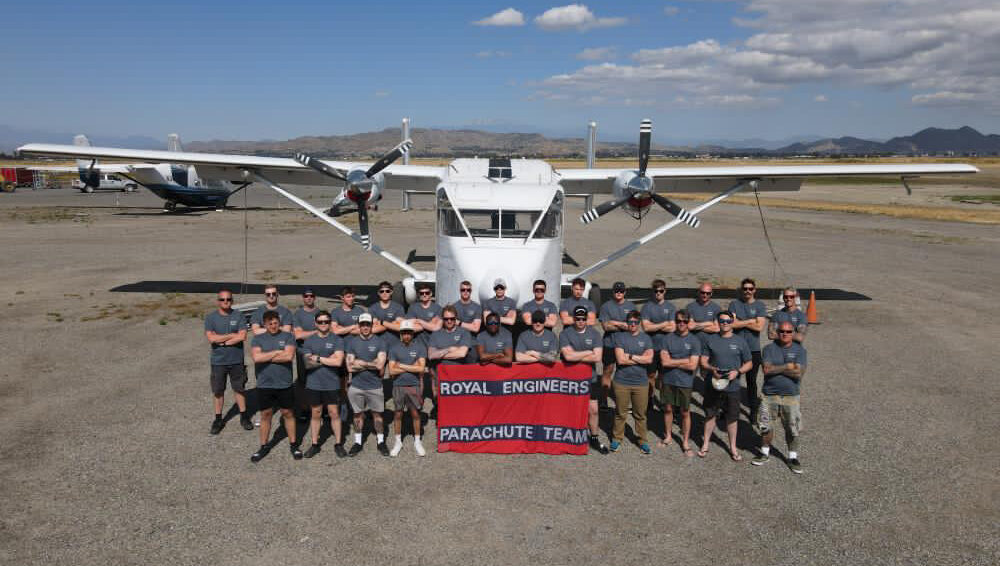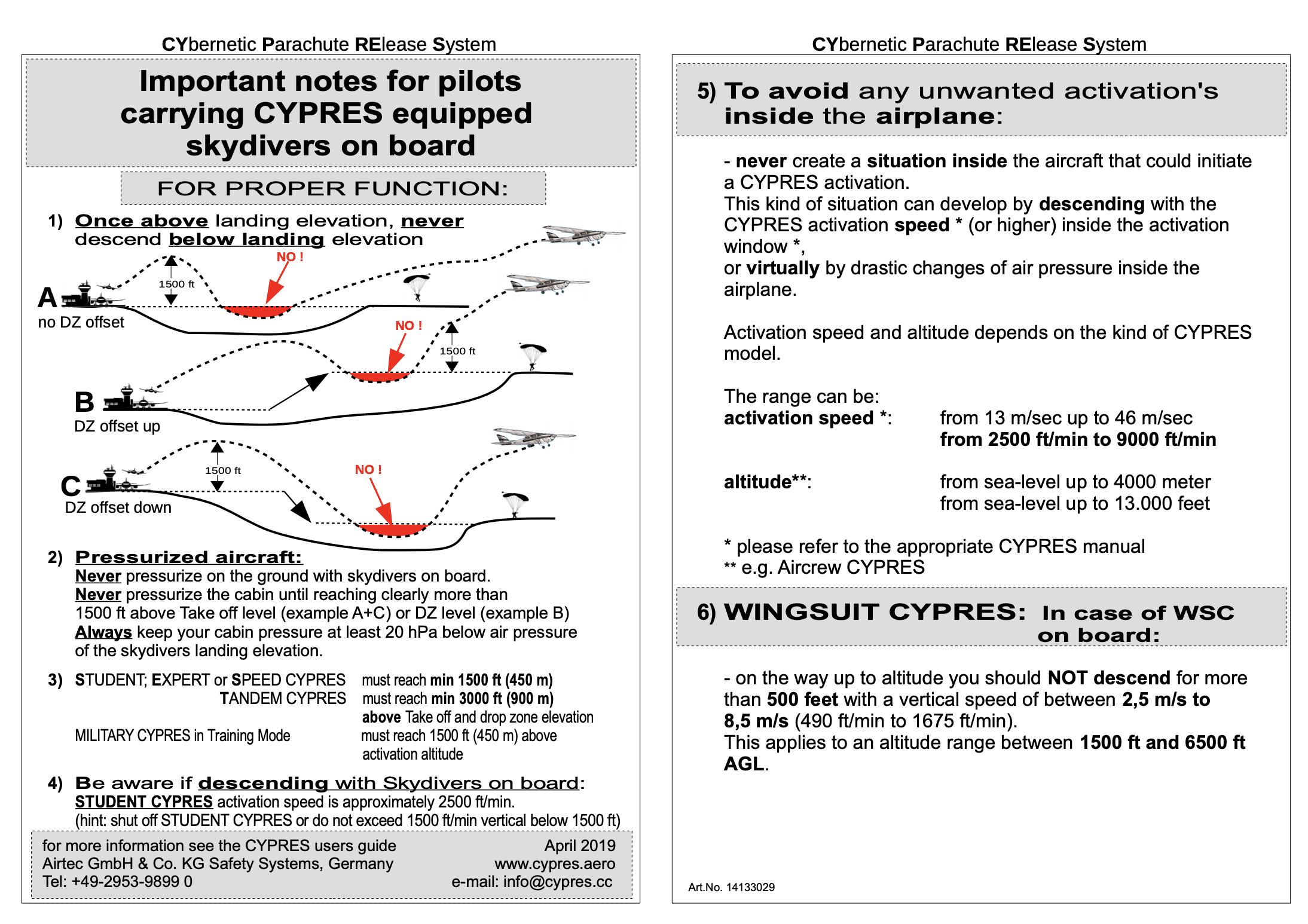
Case Study: Riding Down
Friday, September 6, 2024
Skydive for long enough and at some point you be required to descend in the plane. Nobody wants to do this. Pilots would rather land empty than full, and AFF and tandem instructors would rather get their work done now rather than later. Students want to progress, jumpers want to jump, and dropzones want to run a successful business. It sucks, but sometimes you just gotta do it.
Early in 2024, a Skyvan at Lake Elsinore elected to land with the jumpers still inside due to cloud. In the back were a bunch of military skydivers (the kind that use kit most akin to modern sport skydiving) plus a jumpmaster. Due to the descent speed, thirteen CYPRES units fired.
This is not a huge big deal. The situation remained safe from start to finish and the units involved all behaved exactly as they are programmed to, yet it is an expensive oopsie – and while not super common, is worth examining to present a few themes recognisable to all skydivers.
Instead of quietly ordering replacement cutters and not saying anything, wisdom and experience led the way. Full credit to Skydive Elsinore for recognising that contained within was some ground worth covering and contacting CYPRES to share.

Niches
Skydiving is built of niches. By the time you have found a favourite discipline, crafted from time in the sport and various experiences, you are already prioritising some stuff over other stuff. Add to this the formal requirements of training and progress, stir in the operational procedures and myriad moving parts of a dropzone business, sprinkle with the unwritten nebulous rules of skydiving culture, and serve. There is a lot going on, even before you get to the depths of specificity required by military training.
Note: Skydiving can be complicated yo.
It is important to state that while what happened can correctly be considered an error, it is difficult to single out a particular thing to point at as the main reason. This makes the juice of talking about it worth the squeeze – by drawing attention to some important grey areas. The longer you skydive, the more you understand that it is active, clever navigation of the places where there is no definitive answer for behaviour that drives the sport and informs the development of communicable and safe structures.

A lot of military training is purposefully and properly separated from civilian operations, but there are also plenty of places around the world where the most efficient way to keep things moving is by working side by side. A high percentage of military parachuting is clearly identifiable as ‘not sport skydiving’ and indeed vice versa. However, there are plenty of locations where they work best functioning alongside one another, where the edges overlap and the colours run.
There are clear advantages. Instructors with crossover skills are highly useful. Military skydivers who understand the sport are valuable. Civilian jumpers who know more about how the military does stuff are equally so. Also, the pooling of resources helps grease the wheels. However, without a weather eye or a dedicated effort to register them, it is possible or even likely that the specificities don’t exactly leap out at you. It is in these places (such as Skydive Elsinore and many others around the world) that enjoy the scale of operation that can cater to all areas, where more attention being paid to the details is required.

Who is Responsible?
Is it the jumpmaster? Standard procedure for coming down in the plane is to switch off any student CYPRES units. Most often this will be AFF students and their instructors. (If the sport jumpers are landing too then questionable choices may have been made by someone). The pilot flying should be used to this, right?
Is it the pilot? The goal when landing with skydivers on board is to not fire the sport CYPRES units. Student CYPRES control units are generally exposed – to be checked easily and such all the time. In sport rigs, control units are more often hidden away. Better to just descend acceptably slowly so all the sporties can avoid climbing around and over each other turning them off. As the pilot in command, you are busy. The jumpmaster should tell you who is on board, right?
Is it the individual skydivers? As a general rule, you should know your gear. If you are new (or new-ish) you may not be on point (nor are expected to be) about how fast your auto-activation gadget thingy works, and also not about how jump pilots will pretty much point the nose of their aircraft directly at the ground if nothing is stopping them from doing so. The longer you spend in the sport, the harder it is to excuse not knowing these things, but it is also the designated responsibility of those connected to the operation to handle them properly when called upon. The jumpmaster and the pilot do all this, right?

Consider This: Out of any bunch of military folks called upon to jump for work, some get into skydiving, but plenty do not, and parachute equipment is just another set of kit they apply to their job. Mostly these are the pointy-end types, whose business it is to know their gear as part of a demanding role, yet something as subtly specific as the themes of this article are understandably more likely the province of the purposefully more interested and involved – the sport skydivers among them, plus the instructors and such.

Settings and Units
Both instructors and pilots at AFF program dropzones will be used to switching off student CYPRES units upon need of a descent. The student unit activation speed is designed to save during canopy malfunctions and has a low rate of 29mph. This is way slower than the patience threshold of your average jump pilot.
There is more though. Quite a few different military CYPRES units exist, with various activation parameters that consider factors outside normal sport skydiving. A mixed day on the dropzone can have CYPRES units that activate from 750ft to 2500ft and 29mph to 102mph – before you even consider user-selectable variations such as activation altitude, single-use offset, or the programmable versions the fancy soldiers use.
Note: If you jump somewhere that runs a mixed operation, read the available information about the kit used by those around you. Heck, read it anyway – because knowing things is cool.
Consider This: Different military structures have different rules. Following an incident in the UK, the Brits are required to add 500ft to the their activation altitude default for all military parachuting. Sport skydivers generally consider this as too much, but the British MOD will defend it as the correct choice after every factor has been considered. When skydiving recreationally, most will return their units to the default of 750ft (or their usual preferred increase from there such as +200ft or +300ft). How easy is it to forget this if you switch from work to fun regularly, and what does that mean?

Habits
If there is a lesson for everyone here, it is that while there is a lot to be said for developing good habits – complacency grown from habitual behaviour can just as easily get you into trouble. Repetition and muscle memory are how we progress and can easily save your life, but there is also a trap involved that can cause you to drop your guard. Try to build into your regular process the behaviour of taking a moment to consider if anything about what you are doing falls outside of normal. If on every jump you allow for a bit of a think about what there might be that is unusual, the chances of catching an outlier increase. Noticing something like this because you are generally bright-eyed and bushy-tailed will carry you far in any situation, operation, or institution.
Complexities
This article is not designed to make things sound more complicated than they need to be. Firing thirteen units in one go is an irregularity, but worth talking about because there is a little bit of relevance for everyone. No single factor is to blame, and everyone involved behaved within their normal and accepted safety parameters – yet a thing happened that could perhaps be avoided.
Since the invention of the CYPRES, we have gone from ‘just turn it on and forget about it’ to actively prioritising education about the ways we need to think about how and why our unit functions. This process was never absent, but we are aiming for better and more thorough knowledge, communicated sooner and delivered wider. As skydiving continues to grow and diversify, it is the edges of possibility that require attention so we can get things done safely and efficiently – whatever they may be.
Thanks to Jay Stokes, Jase Hughes and Skydive Elsinore.
Tags: CYPRES
Adventure, Tips, and Adrenaline
Subscribe to Our Newsletter
By signing up for our newsletter you declare to agree with our privacy policy.

